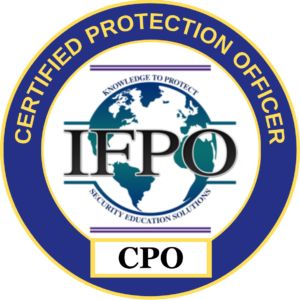Security & Protective Services
Security & Protective Services (SPS) Course
The SPS course is the intermediate course for a SPS pathway. SPS is also used as an advanced course in many Law Enforcement Pathways.
Security and Protective Services prepares individuals to perform the duties of professional security officers, including patrol and investigative activities, traffic control, crowd control, public relations, witness interviewing, evidence collection and management, information protections, customer relations and the legal aspects regarding the security profession. Basic crime prevention methods, risk assessments, Crime Prevention Through Environmental Design, dignitary protection responsibilities and officer safety and use of force are also included. This course is instrumental in the preparation of the student to assume the position of an entry level Certified Security and Protection Officer.
Instructional Plans & Resources
LAPSEN Unit Plans
LAPSEN has a complete course (120-150 hours) of unit lesson plans available to members – Click Here to access.
Other Lesson Plan Sources
California Educators Together– The great state of California has an insane amount of resources and lessons. Be sure to search with different key words. You do have to have an account – but they give them to all teachers: Click Here
Texas CTE Lesson Plans – They have some materials for Law & Public Safety: Click Here
LAPSEN CPOI – When instructors get certified to teach CPO, they must submit a lesson plan. There are not many right now, but more will be coming: Click Here
Industry Recognized Credential (IRC) for this Course
 Certified Protection Officer (CPO) Certification
Certified Protection Officer (CPO) Certification
The Certified Protection Officer certification demonstrates students have the basic knowledge, skills, and experience to understand security and protection officers, and their role and responsibilities within the public safety and criminal justice system.
The CPO certificate is recognized by:
- U.S. Department of Labor
- ASIS International
- Canadian General Standards Board
- Thousands of American companies
The CPO satiates all Perkins legislative requirements for Industry Recognized Credentials.
Learn more about the CPO – Click Here or email holly@lapsen.org
MicroCredentials (MC) for this Course
All MicroCredentials are being developed and should be ready soon.
Security and Protective Services Course Standards
Click Here to open the SPS standards document.
Section 1: Foundations of Protection Officer
|
Standard 1: Describe concepts and theories of asset protection and security. |
|
Standard 2: Describe the security officer of the 21st century. |
|
Standard 3: Describe the legal aspects of security. |
|
Standard 4: Explain effective communications. |
Section 2: Roles & Responsibilities of the Protection Officer
|
Standard 1: Describe the roles of a protection officer. |
|
Standard 2: Define security awareness |
|
Standard 3: Describe a sustainable culture of security |
|
Standard 4: Explain role in critical information infrastructure protection |
|
Standard 5: Describe fire prevention, detection and response in the context of a protection officers responsibility |
|
Standard 6: Describe an all hazards approach. |
Section 3: Patrol Principles
| Standard 1: Describe how patrol is conducted in protective services. |
| Standard 2: Explain protection officer safety and use of force |
| Standard 3: Describe how protection officers lawfully apprehend and detain offenders. |
| Standard 4: Identify crime scene and incident scene procedures. |
| Standard 5: Describe concepts and practices of security professionals. |
| Standard 6: Explain the basics of report writing. |
Section 4: Concerns in the Workplace
|
Standard 1: Explain how health and hazard assessments are completed |
|
Standard 2: Describe how sites can mitigate shooter and assailant threats |
|
Standard 3: Describe crisis intervention |
|
Standard 4: Evaluate how mental health, including substance abuse, impact the workplace |
|
Standard 5: Describe workplace crime and deviance |
Section 5: Concepts of Physical Security
|
Standard 1: Describe access control |
|
Standard 2: Identify types of contraband detection |
|
Standard 3: Describe how drones are used in security and protective services |
|
Standard 4: Discuss physical security concepts |
|
Standard 5: Describe the fundamentals of alarm systems |
Section 6: Risk Management
|
Standard 1: Explain risk |
|
Standard 2: Describe the risk management process. |
|
Standard 3: Describe the potential impact of emergencies on people and organizations. |
Section 7: Crowd Management & Event Planning
|
Standard 1: Describe common traffic control strategies |
|
Standard 2: Explain how special events are planned |
|
Standard 3: Identify potential issues with labor and management |
|
Standard 4: Describe handling VIPs |
Section 8: Terrorism
|
Standard 1: Describe surveillance |
|
Standard 2: Explain how espionage threatens non-government entities |
|
Standard 3: Explain terrorism |
|
Standard 4: Explain how responses to threats that can result in evacuation are processed |
|
Standard 5: Explain cybersecurity |
Section 9: Ethics & Leadership
|
Standard 1: Explain professional security officer ethics |
|
Standard 2: Describe how networking is an important part of protection officers jobs |
|
Standard 3: Describe how protection officers serve as leaders |
Section 10: Career Readiness
Standard 1: Describe best practices for time and stress management
Standard 2: Explain proper methods to deal with critical incident stress
Standard 3: Identify how to respond to medical situations commonly occurring in public environments
Standard 4: Identify training and certifications for career advancement
Standard 5: Create a career plan